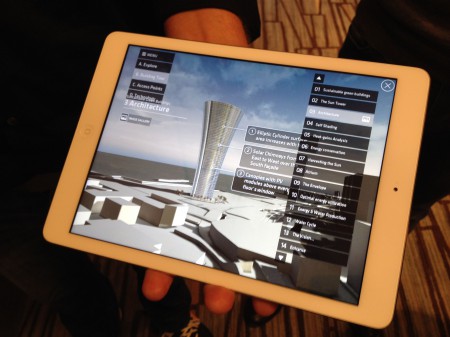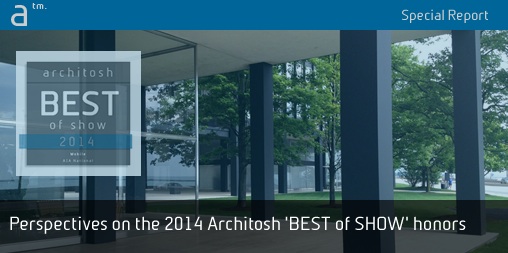Introduction
Last year senior associate editor Pete Evans AIA wrote an excellent article regarding the framework from which the Architosh BEST of SHOW awards were going to adjudge innovation and progress in information technologies for architectural practice. That ‘framework’ remains largely relevant this year. However, there are certain aspects of that framework that deserve further application and clarity.
Pete ended that article from last year with a quote from Sir Ken Robinson, imminent educational visionary who said this about tools: “Tools themselves are always neutral (relying on a person’s intentions). It’s all about the possibilities people see in them and the opportunities the tools provide for imaginative work.”
Advertisement
It is fitting that we ended with that quote last year and begin with it this year. The intentions of architects the meaning of design intent come into sharp focus this year. I should point out however—before this article goes much further—that, unfortunately due to personal commitments, my friend and colleague Pete Evans was not able to attend AIA this year. I have tackled these honors, bravely, solo.
Design Intent and the Intentions of Architects
Let’s begin by asking: “what are the intentions of architects…by and large?” And can we answer that question partially by what the profession tends to focus praise on?
Traditionally both the profession and society have focused praise on design innovation or innovation within ‘architectural expression’, that last term pulled from the pages of academia and late 20th century ‘contexturalism’ which, like other periods, focuses attention on matters of what buildings look like. It has been customary to heap this praise on a single individual. This has been the norm; award programs, book editors and writers and architectural critics continue to reinforce the prevailing pattern.
Yet there is a new direction challenging this pattern and it is causing serious riffs here and there within the profession. We saw it two years ago with the Pritzker Prize controversy over Denise Scott Brown which called for the honor, given to Robert Venturi (Pritzker Prize Laureate for 2012), to be shared equally with his wife and long time creative partner.
There is a stirring of support to recognize that the architectural profession is, after all, a team sport!
The continued maintenance of the word “I” in the word “team”, where it doesn’t possess a spot to sit, is itself a long-term threat to the entire profession. It’s a threat because is denies right from the opening gate that any young architect should be thinking properly of her craft as a well-coordinated creative effort by many hands. Under these shifting conditions the intentions of architects should begin to pluralize away from the view of star-chitecture concerns.
It’s also a threat because it challenges the required plurality of inputs that should be considered in modern building design. These inputs are manifesting because they’re responding to larger global concerns, like global warming and the scarcity of resources. But it’s not just that—architects today need more expertise and it’s no longer reasonable for society to expect a single individual to possess that much skill and knowledge. However, it is very reasonable for an entire architecture firm, of even modest size, to do so.
Today’s leading firms are succeeding because they get this. Their acknowledgement of wider inputs into successful architectural design is shifting their priorities. In turn their staff make-up has a more relevant complexion. Their public-facing side may still focus attention on the firm’s single owner, owners or star talent, but their private-facing side reveals a deeper truth and that story is being told in the changing landscape of architectural tools and technology.
Design Intent and Design Performance
In the year that has passed since Denver performance-based design has begun to really ramp up. Last year we identified three key lessons shaping the architectural IT landscape:
- Lesson One — Social and Democratization of IT
- Lesson Two — Computation Power and the Cloud
- Lesson Three — Creativity and the Contemplative Pace
Design performance sits at the center of the second lesson. But it also plays a role in its interaction with creativity. Within the Architosh BEST of SHOW honors there will be a continued focus on these three broad-brush areas because we believe so firmly in their impact on the future of the profession.
Over the next few years we anticipate an acceleration in cloud-based computational power and inputs into design practice, further mobility and richer capacity with mobile devices, and continued social forces and their impact on architectural design in the form of big data, the role of sensors and lasers and a social push for greater freedom over who owns and controls the data and in what form. That was a mouthful. But’s it’s happening!
Today the term design intent has waning relevancy. In the Autodesk Innovation Forum in Chicago at AIA Phil Bernstein of Autodesk argued that the profession is going to lead its way back to the era of the master builder, with less separation between constructor (builder) and architect. With architects acquiring 3D printers, constructors building parts via CNC machines and similar equipment, and with big manufacturers able to provide custom manufacturing all three entities are getting linked across the BIM and PLM (product life-cycle) pipeline using essentially similar or the same technology.

01 – At the Autodesk Innovation Forum I had the chance to meet Viktor Nordstrom, CEO of CL3VER, the folks behind an engaging new cloud plus mobile solution for project visualization. Sadly, this app was not on display on the show floor any official way. Innovation is very much alive in mobile and cloud.
The Maker Movement furthers intensification in the profession and in young professionals, in particular, in actually making things in the way of digital to 3D prototyping. Who is to say that architects in the near future don’t actually start manufacturing parts for the buildings they actually design—lending a degree of customization, originality and problem solving beyond their adjacent peers? The 4D and 5D technologies of BIM increasingly link the architect to the actual building process, while the virtual building concept pioneered by Graphisoft evolves to the level of simulation and optimization. What does “design intent” now mean in the era of simulated building performance, simulated occupancy, and virtualized construction?
Arguing for Insight
In the Autodesk Innovation Forum Phil Bernstein presented a chart that demonstrated progress from the various eras of the architect’s documentation (on x-axis) moving from the era of documentation, to era of BIM, to the emerging era of context. If the era of BIM was about optimization the new era of context is about integration of simulations and validation, noted Bernstein.
On the y-axis Bernstein’s chart shows increasing “insight” afforded to the architect and the design-build team in the era of context. For the value of context (and situation) to bear full value to simulation and validation in building design two key things must come true: social data must be reliable and accessible and the sources of this data must be publicly trusted. Insight can certainly go up when architects harness more data, including social data streams, but if this data is not honestly presented then these insights may bear false results in urban and architectural design.
This leads us back to the beginning. Yes, as Sir Ken Robinson noted, tools themselves tend to be always neutral. But tools armed with data and social data, in the era of context, can suddenly become not neutral when they are filled with skewed or biased data. And this says nothing about the inner issue of will architects honestly work with data?
Is this okay? Will society continue to entrust the profession’s judgements, aesthetic and data-scientific, in the era of context? These are questions that remain to be worked out.
next page: Reviewing the Winners




Reader Comments
#CAD Perspectives on the 2014 Architosh BEST of SHOW awards at AIA National http://t.co/4vw6HUFutC
#CAD Perspectives on the 2014 Architosh BEST of SHOW awards at AIA National http://t.co/4vw6HUFutC
Comments are closed.